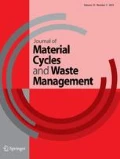Abstract
The chemical states of arsenic contained in 4 kinds of sewage sludge incineration ash and insolubilized materials are analyzed using a leaching test (Japan environment agency notification no. 46: JLT-46), X-ray absorption fine structure spectroscopy, ion chromatography inductively coupled plasma mass spectrometry, and a chemical equilibrium model calculation. The arsenic in samples mainly exists as As(V). Three of the four kinds of insolubilized materials meet the environmental quality standards for soil after hydroxide calcium insolubilization treatment, and it is suggested that the arsenic formed Ca3(AsO4)24H2O. Two kinds of insolubilization material meet the standards after iron(II) sulfate treatment, and it is inferred that arsenic was absorbed onto iron hydroxide.







Similar content being viewed by others
References
Ministry of land infrastructure transport and tourism, http://www.mlit.go.jp/mizukokudo/sewerage/crd_sewerage_tk_000124.html. Accessed 13 Feb 2017
Todorovic J, Svensson M, Herrmann I, Ecke H (2006) Artificial carbonation for controlling the mobility of critical elements in bottom ash. J Mater Cycles Waste Manag 8(2):145–153
Chakraborti D, Mukherjee SC, Pati S, Sengupta MK, Rahman MM, Chowdhury UK, Lodh D, Chanda CR, Chakraborti AK, Basu GK (2003) Arsenic groundwater contamination in Middle Ganga Plain, Bihar, India: a future danger? Environ Health Perspect 111(9):1194–1201
Masuda H (2000) Geochemical cycle of arsenic in the earth's surface and mechanisms of its pollution of groundwaters. J Groundw Hydrol 42(4):295–313 (in Japanese)
Sakamoto T, Koide N, Nomura N (2003) Yakuzai tenka to kanetsushori niyoru gesuiodeishokyakuhai karano hiso to seren no yoshutsu yokusei hoho. Gesuido Kenkyu Happyokai Kouenshu 40th, pp 406–408 (in Japanese)
Abe Y, Nagano M, Aizawa Y (2003) Hiso shori taisaku ni muketa mzushori oyobi odeishori no kento. Gesuido Kenkyu Happyokai Kouenshu 40th, pp 898–900 (in Japanese)
Kato H, Hayashi M (2004) Gesuiodei shokyakuhai karano hiso oyobi seren yoshutsu yokusei taisaku nitsuite. Saisei to Riyo 27(103):93–97 (in Japanese)
Wan X, Wang W, Ye T, Guo Y, Gao X (2006) A study on the chemical and mineralogical characterization of MSWI fly ash using a sequential extraction procedure. J Hazard Mater 134(1):197–201
Kiser JR, Manning BA (2010) Reduction and immobilization of chromium(VI) by iron(II)-treated faujasite. J Hazard Mater 174(1):167–174
Eighmy TT, Eusden JD Jr, Domingo DS, Stampfli D, Martin JR, Erickson PM (1995) Comprehensive approach toward understanding element speciation and leaching behavior in municipal solid waste incineration electrostatic precipitator ash. Environ Sci Technol 29(3):629–646
Kida A, Noma Y, Imada T (1996) Chemical speciation and leaching properties of elements in municipal incinerator ashes. Waste Manag 16(5):527–536
Cobo M, Galvez A, Conesa JA, Correa CM (2009) Characterization of fly ash from a hazardous waste incinerator in Medellin, Colombia. J Hazard Mater 168(2–3):1223–1232
Takaoka M, Shiono A, Nishimura K, Yamamoto T, Uruga T, Takeda N, Tanaka T, Oshita K, Matsumoto T, Harada H (2005) Dynamic change of copper in fly ash during de novo synthesis of dioxins. Environ Sci Technol 39(15):5878–5884
Sammut ML, Noack Y, Rose J, Hazemann JL, Proux O, Depoux M, Ziebel A, Fiani E (2010) Speciation of Cd and Pb in dust emitted from sinter plant. Chemosphere 78(4):445–450
Kawai J, Adachi H, Hayakawa S, Zheng SY, Kobayashi K, Gohshi Y, Maeda K, Kitajima Y (1994) Depth selective X-ray absorption fine structure spectrometry. Spectrochim Acta 49B:739–743
Kawai J, Hayakawa S, Esaka F, Zheng SY, Kitajima Y, Maeda K, Adachi H, Gohshi Y, Furuya K (1995) Depth-selective chemical state analysis of fine particles using X-ray absorption. Anal Chem 67(9):1526–1529
Miyashita S, Shimoya M, Kaise T (2009) Rapid determination of arsenic species in freshwater organisms from the arsenic-rich Hayakawa River in Japan using HPLC-ICP-MS. Chemosphere 75(8):1065–1073
Seto Y (2007) Analytical chemistry contributing to crisis management in poisoning cases. Bunsekikagaku 56(12):981–991 (in Japanese)
Tazaki M (2011) Gesui Odei Shokyaku Shisutemu no Enerugi Kouritsuka ni kansuru Kenkyu, PhD Thesis, Kyoto University, Kyoto, Japan (in Japanese)
Kawai H, Ikuma N, Yoneyama T (2009) Gesui Odei Shokyakuhai no Jukinzoku Fuyokashori Gijutsu nitsuite. Annu Rep Yokohama Environ Sci Res Inst 33:91–95 (in Japanese)
Mohan D, Pittman CU Jr (2007) Arsenic removal from water/wastewater using adsorbents—A critical review. J Hazard Mater 142:1–52
Sakamoto T, Koide N, Nomura N (2002) Tetsukeiyakuzai niyoru gesuiodeishokyakuhai karano hiso to seren no youshutsu yokuseihoho. Gesuido Kenkyu Happyokai Kouenshu 39th, pp 896–898 (in Japanese)
Takaoka M, Yamamoto T, Fujiwara S, Oshita K, Takeda N, Uruga T (2008) Chemical states of trace elements in sewage sludge incineration ash by using X-ray absorption fine structure. Water Sci Technol 57(3):411–417
Tokoro C, Shimizu T, Hirai K, Badulis GC, Sasaki H (2005) As(V) removal by Fe(III), Al or Pb salts and rapid solid/liquid separation in waste water containing dilute arsenic—A fundamental study for efficient treatment of waste water containing dilute arsenic (part 1). Shigen Sozai 121(8):399–406
Yamashita M, Honda K (2008) Examination on utilization of regenerated amorphous iron oxide for adsorbent of arsenic. J Environ Chem 18(4):553–558 (in Japanese)
Lenoble V, Bouras O, Deluchat V, Serpaud B, Bollinger JC (2002) Arsenic adsorption onto pillared clays and iron oxides. J Colloid Interface Sci 255:52–58
Carrilo A, Drever JI (1998) Adsorption of arsenic by natural aquifer material in the San Antonio-El Triunfo mining area, Baja California, Mexico. Environ Geol 35(4):251–257
Author information
Authors and Affiliations
Corresponding author
Rights and permissions
About this article
Cite this article
Funatsuki, A., Yamaguchi, S., Shiota, K. et al. Chemical states of arsenic contained in sewage sludge incineration ash and insolubilized material. J Mater Cycles Waste Manag 20, 955–964 (2018). https://doi.org/10.1007/s10163-017-0654-9
Received:
Accepted:
Published:
Issue Date:
DOI: https://doi.org/10.1007/s10163-017-0654-9




